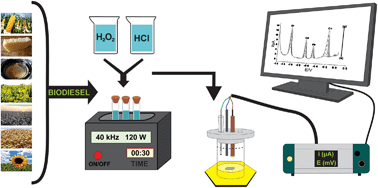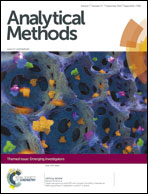Ultrasound-assisted digestion of biodiesel samples for determination of metals by stripping voltammetry
Abstract
The ultrasound-assisted digestion of biodiesel samples is demonstrated for the first time. The efficiency of the proposed sample preparation method was evaluated for trace metal determination by stripping voltammetric techniques, which are more susceptible to residual carbon content (RCC) in digestates. Biodiesel samples (50–75 mg) were treated in glass tubes, with a mixture of 3.0 mL of concentrated HCl and 4.5 mL of H2O2, placed inside an ultrasonic bath (40 kHz frequency and 120 W) exactly over the region of higher ultrasound intensity and sonicated for 40 min. These parameters were optimized using factorial design experiments for the analysis of spiked samples. Recovery values between 94 and 108% for zinc, cadmium, lead, copper and mercury were verified under optimized conditions. RCC values after US-assisted digestions were in the range of 3.05–3.75% using covered glass tubes, which are acceptable values for the accurate voltammetric determination of metals. These results indicate that the proposed sample preparation method presents comparable performance to traditional or microwave-assisted acid digestions and can be associated with on-site electroanalysis using screen-printed electrodes.

- This article is part of the themed collection: Emerging Investigators

 Please wait while we load your content...
Please wait while we load your content...